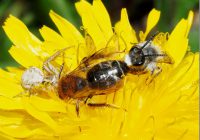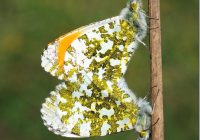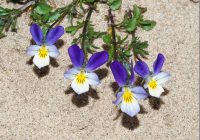Dr Phil Smith’s Wildlife Notes
Apr 2019
A frequent refrain in these notes since 2000 has been spring droughts. April lived up to its reputation, only nine days having measurable rainfall. Strong drying winds from 5th to 16th didn’t help, these being followed by a heat-wave with temperatures up to 25oC and the inevitable moorland fires. Whatever happened to April showers? As usual, a named storm on 27th produced hardly any rain here. What little we did get stimulated a few Natterjack Toads to spawn. I counted 14 strings on the southern Green Beach, adding to 15 in March. However, a total of 29 spawn strings hardly compares with 274 at the same site in 2008. Even more concerning is that I didn’t see a single adult Natterjack during March and April.
Nevertheless, there were many highlights during the month, the first being when Patricia Lockwood phoned to tell me she had found Wood Anemone at Freshfield Dune Heath. Sure enough, there were five beautiful plants in flower in the woodland on the southern boundary of the reserve, this being a new native species for the Sefton Coast. Other finds there included a less welcome sapling of Sitka Spruce, while a shady ditch produced a previously recorded patch of Hard Fern, some Soft Shield-ferns and a few plants of Ramsoms, all scarce in the district.
Joshua Styles joined me on 6th to visit several bushes of the very rare Don’s Willow at Hightown dunes. This hybrid has particularly attractive catkins, each bush having distinctly different characteristics. However, they don’t live forever and Josh is interested in taking cuttings for his North West Rare Plant Initiative. He was also impressed by the huge colonies of Vernal Mining Bees on south-facing dune ridges, together with smaller Sandpit Mining Bees and tiny red Blood Bees. I also went to Lifeboat Road, Formby, to check up on the large bush of Don’s Willow that I first found in about 40 years ago and named “Big Daddy”. Unfortunately, three-quarters of the bush has died, probably of old age, but a nearby offshoot is flourishing.
Visits to the Pinfold area of Ainsdale Sand Dunes National Nature Reserve were rewarded with a fine display of the increasingly rare Shepherd’s-cress at its long-established colony near the railway line. Trying to photograph a female Sandpit Mining Bee on a Dandelion, I was surprisedwhen a male appeared and attempted to mate with the female. As I snapped away, I suddenly realised that a Crab Spider had grabbed the female and was feeding on it. The male bee soon lost interest and flew off. A little later, I bumped into Pete Kinsella, who has a keen interest in hoverflies. A pair I spotted mating on a Grey Willow bushwas identifiedas the Pale-shouldered Brachyopa (Brachyopa scutellaris), an uncommon woodland hoverfly.
A visit to Hightown dunes on 20th proved eventful. Newly arrived migrants included several Willow Warblers, Chiffchaffs, Whitethroats, two Tree Pipits, three Grasshopper Warblers and a pair of Stonechats. Amongst the great variety of insects, I spotted a black-and-red Hairy Sand-wasp. It seemed preoccupied, so I approached carefully and watched while it excavated a hole and removed a large caterpillar, which it had previously paralysed as food for its offspring. It then shoved it back into the hole before kicking sand to close the entrance. I had read about this fascinating and complex behaviour but hadn’t seen it before.
It seems to have been an excellent spring for Orange Tips. The Wildlife Trust’s Haskayne Cutting Nature reserve is usually a good place to see them and so it proved on 21st when I counted 13 males and two females. Having a snack on a convenient bench-seat, I spotted a mating pair and managed to get photographs of this usually hyperactive butterfly.
Two days later, I was walking on Ainsdale Sandhills Local Nature Reserve when I bumped into a chap who said he was hoping to see Sand Lizards. While we chatted, he pointed out fresh lizard tracks in the sand and, soon after, a bright-green male Sand Lizard appeared. Then, two more males and a female, which one of the males grabbed, in an attempt to mate. What a thrill! Walking on, I was delighted to find both Slender and Common Groundhoppers and some Dune Pansies, one of our most striking wildflowers.
Joyce Jarvis kindly got in touch to report Spotted Medic at Morrison’s carpark in Southport, a new plant for me. Moving on to Marshside, dozens of Red-and-black Froghoppers near the main hide were spectacular. Finally, Patricia Lockwood and I did some botanical recording on Birkdale Common to support its possible designation as a Local Wildlife Site. We confirmed the ongoing presence of several rare plants, including the nationally endangered Annual Knawel and a brilliantly white colony of an uncommon hybrid between the alien Snow-in-Summer and the native Field Mouse-ear. Our search for plants was interrupted by a fantastic male Brimstone butterfly, the original “Butter-coloured fly”.





